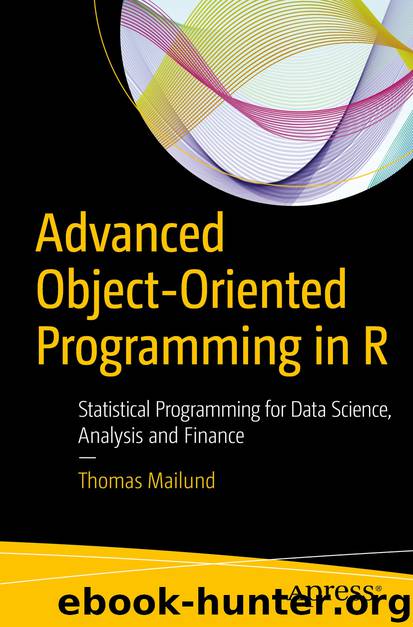Advanced Object-Oriented Programming in R by Thomas Mailund

Author:Thomas Mailund
Language: eng
Format: epub
Publisher: Apress, Berkeley, CA
Bayesian Linear Regression
The simplest form of linear regression fits a line to data points. Imagine we have vectors x and y, and we wish to produce coefficients w[1] and w[2] such that y[i] = w[1] + w[2] x[i] + e[i] where the e is a vector of errors that we want to make as small as possible. We typically assume that the errors are identically normally distributed when we consider it a statistical problem, and so we want to have the minimal variance of the errors. When fitting linear models with the lm function, you get the maximum likelihood values for the weights w[1] and w[2], but if you wish to do Bayesian statistics you should instead consider this weight vector w as a random variable, and fit it to the data in x, while y means updating it from its prior distribution to its posterior distribution.
A typical distribution for linear regression weights is the normal distribution. If we consider the weights’ multivariate normal distributed as their prior distribution, then their posterior distribution given the data will also be normally distributed, which makes the mathematics very convenient.
We will assume that the prior distribution of w is a normal distribution with mean zero and independent components, so a diagonal covariance matrix. This means that, on average, we believe the line we are fitting to be flat and going through the plane origin, but how strongly we believe this depend on values in the covariance matrix. This we will parameterize with a so-called hyperparameter, a, that is the precision—one over the variance—of the weight components. The covariance matrix will have 1/a on its diagonal and zeros off-diagonal.
We can represent a distribution over weights as the mean and covariance matrix of a multinomial normal distribution and construct the prior distribution from the precision like this:
weight_distribution <- function(mu, S) {
structure(list(mu = mu, S = S), class = "wdist")
}
Download
This site does not store any files on its server. We only index and link to content provided by other sites. Please contact the content providers to delete copyright contents if any and email us, we'll remove relevant links or contents immediately.
The Mikado Method by Ola Ellnestam Daniel Brolund(20713)
Hello! Python by Anthony Briggs(20001)
Secrets of the JavaScript Ninja by John Resig Bear Bibeault(18323)
The Well-Grounded Java Developer by Benjamin J. Evans Martijn Verburg(17678)
OCA Java SE 8 Programmer I Certification Guide by Mala Gupta(17490)
Kotlin in Action by Dmitry Jemerov(17298)
Algorithms of the Intelligent Web by Haralambos Marmanis;Dmitry Babenko(16313)
Grails in Action by Glen Smith Peter Ledbrook(15459)
Sass and Compass in Action by Wynn Netherland Nathan Weizenbaum Chris Eppstein Brandon Mathis(13323)
Test-Driven iOS Development with Swift 4 by Dominik Hauser(10415)
Windows APT Warfare by Sheng-Hao Ma(7833)
Layered Design for Ruby on Rails Applications by Vladimir Dementyev(7549)
Blueprints Visual Scripting for Unreal Engine 5 - Third Edition by Marcos Romero & Brenden Sewell(7451)
Solidity Programming Essentials by Ritesh Modi(4568)
Functional Programming in JavaScript by Mantyla Dan(4445)
Hands-On Full-Stack Web Development with GraphQL and React by Sebastian Grebe(4433)
WordPress Plugin Development Cookbook by Yannick Lefebvre(4388)
Unity 3D Game Development by Anthony Davis & Travis Baptiste & Russell Craig & Ryan Stunkel(4270)
The Ultimate iOS Interview Playbook by Avi Tsadok(4252)
